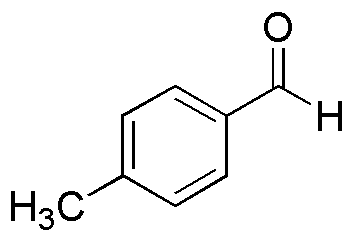p-Tolualdehyde is widely utilized in research focused on:
- Flavor and Fragrance Industry: This compound is used to create various flavors and fragrances due to its pleasant aroma, making it popular in perfumes and food flavorings.
- Synthesis of Pharmaceuticals: p-Tolualdehyde serves as an important intermediate in the synthesis of various pharmaceutical compounds, enhancing the efficiency of drug development.
- Organic Synthesis: It acts as a building block in organic chemistry, allowing researchers to create complex molecules for various applications, including agrochemicals and dyes.
- Polymer Production: The compound is utilized in the production of specialty polymers, contributing to materials with enhanced properties for industrial applications.
- Research and Development: In laboratories, it is often used as a reagent in chemical reactions, facilitating the study of reaction mechanisms and the development of new synthetic methods.
General Information
Properties
Safety and Regulations
Applications
p-Tolualdehyde is widely utilized in research focused on:
- Flavor and Fragrance Industry: This compound is used to create various flavors and fragrances due to its pleasant aroma, making it popular in perfumes and food flavorings.
- Synthesis of Pharmaceuticals: p-Tolualdehyde serves as an important intermediate in the synthesis of various pharmaceutical compounds, enhancing the efficiency of drug development.
- Organic Synthesis: It acts as a building block in organic chemistry, allowing researchers to create complex molecules for various applications, including agrochemicals and dyes.
- Polymer Production: The compound is utilized in the production of specialty polymers, contributing to materials with enhanced properties for industrial applications.
- Research and Development: In laboratories, it is often used as a reagent in chemical reactions, facilitating the study of reaction mechanisms and the development of new synthetic methods.
Documents
Safety Data Sheets (SDS)
The SDS provides comprehensive safety information on handling, storage, and disposal of the product.
Product Specification (PS)
The PS provides a comprehensive breakdown of the product’s properties, including chemical composition, physical state, purity, and storage requirements. It also details acceptable quality ranges and the product's intended applications.
Certificates of Analysis (COA)
Search for Certificates of Analysis (COA) by entering the products Lot Number. Lot and Batch Numbers can be found on a product’s label following the words ‘Lot’ or ‘Batch’.
*Catalog Number
*Lot Number
Certificates Of Origin (COO)
This COO confirms the country where the product was manufactured, and also details the materials and components used in it and whether it is derived from natural, synthetic, or other specific sources. This certificate may be required for customs, trade, and regulatory compliance.
*Catalog Number
*Lot Number
Safety Data Sheets (SDS)
The SDS provides comprehensive safety information on handling, storage, and disposal of the product.
DownloadProduct Specification (PS)
The PS provides a comprehensive breakdown of the product’s properties, including chemical composition, physical state, purity, and storage requirements. It also details acceptable quality ranges and the product's intended applications.
DownloadCertificates of Analysis (COA)
Search for Certificates of Analysis (COA) by entering the products Lot Number. Lot and Batch Numbers can be found on a product’s label following the words ‘Lot’ or ‘Batch’.
*Catalog Number
*Lot Number
Certificates Of Origin (COO)
This COO confirms the country where the product was manufactured, and also details the materials and components used in it and whether it is derived from natural, synthetic, or other specific sources. This certificate may be required for customs, trade, and regulatory compliance.


